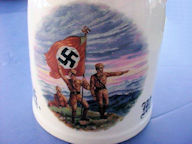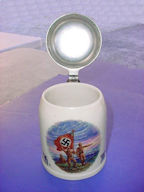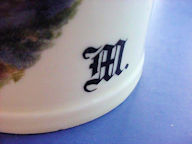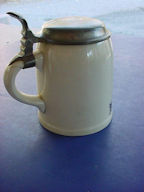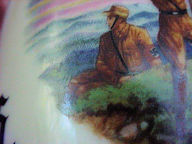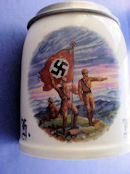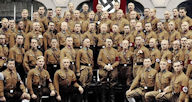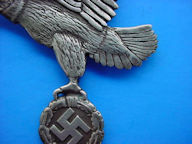|
[ Home Page ] [ Third Reich ] [
Old Reich ] [ Kaiser Reich ] [ Imperial Russia
] [ Axis Powers ] [ Italian Fascist ] [ WW
I ]
[ Landsknecht ] [ Kaiser Wilhelm ] [ Frederick the Great ]
Sturmabteilungen
The SA
Page 15
|
|
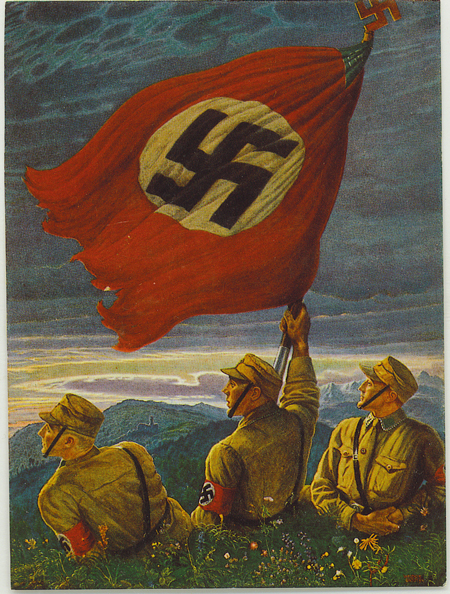
A painting that hung in the Brown House |
"God is with the strong battalions."
|
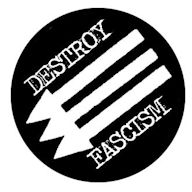
|
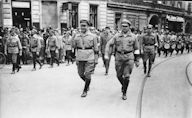
Communist thugs Thälmann and Leow in Berlin June 1927
|
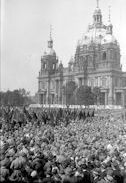
Red rally in Berlin, 1920s
|
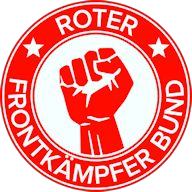
|
Three-Arrow Ring Designed after the “Antifascist Circle” (Item SA 15-1)
|
| DESCRIPTION: This is an interesting ring that we bought from an elderly woman who had a booth at a Munich city flea market. She had a booth selling various used household articles. Our picker was wearing his usual celluloid button that he wears while attending these events that indicates he is interested in purchasing historical antiques of a military nature. The dear lady saw it and she told him she has a ring that belonged to her deceased husband, Karl, who was an SA Brownshirt Storm Trooper and the story is that during the Hitler regime he had occasion after beating a member of the antifascist organization, Iron Front, within an inch of his worthless life, Karl stripped the thug of his finger ring. This happened right after the Communists burned the Reichstag building in Berlin. The building was set ablaze on February 27, 1933, and right after that all known anti-National Socialist meeting places were raided by the SA troopers, who in righteous indignation were mighty rough on these red activists whom they considered criminals of the first order. This lady’s husband left the ring behind along with his dagger and his SA kepi. She already sold the dagger and the cap years before but she never sold the ring until now because she had always been a bit wary of telling the story, but now in her 90s she decided to let this Bavarian lad who wore traditional nationalistic (Trachten) clothing have a chance to have this ring. We learned later that this three-arrow symbol later became popular in the signs and leaflets used by the Red street thugs back in the 1930s and it carried over to the Young People’s Socialist League formed in the U.S. in 1989, but I am sure that none of these idiots ever sported a ring like this one that was wrested from what was most likely the ‘broken’ finger of an early red terrorist. This ring, although not at all pretty like the SA and SS rings, is many times as rare. In all our many years in this business this is absolutely the one and only one we have ever encountered.
PRICE: SOLD
|
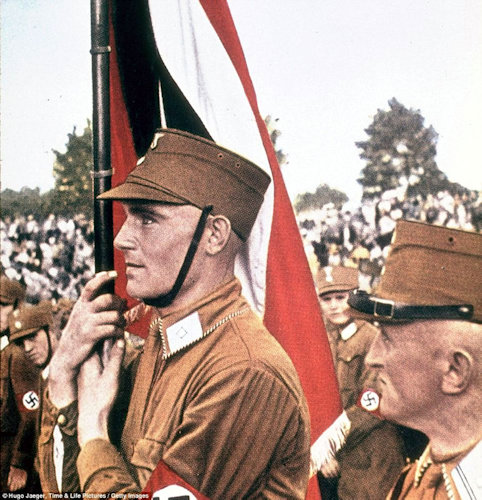
|
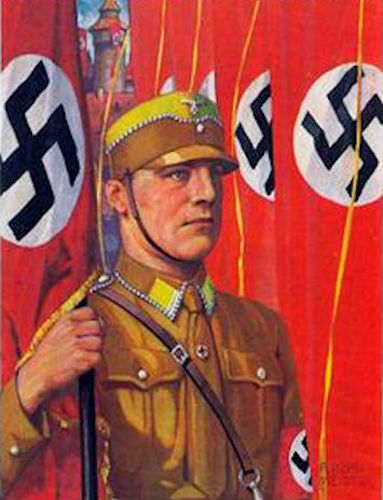
|
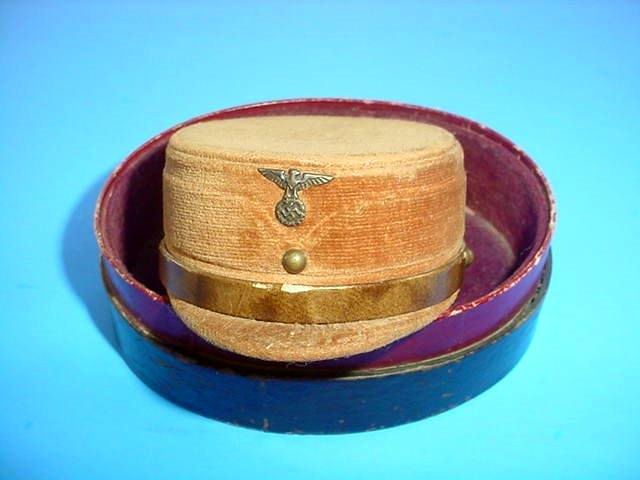
|

|
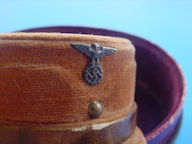
|
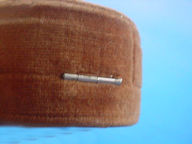
Opener hinge at the back of the kepi
|
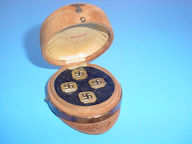
|
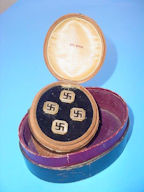
|

|
Special!!! Set of Magnificent Swastika Cufflinks Contained in a Miniature SA Kepi (Item SA 15-2)
|
|
DESCRIPTION: We recently happily acquired this utterly magnificent piece of SA memorabilia. It is comprised of a very accurate little SA kepi. When the top of the kepi is raised, there is revealed a set of fine-jewelry cufflinks in silver with black enamel swastikas as their theme. They are individually set into black velvet. They are comprised of the right and left cufflinks for the uniform shirt, and are of a very high jeweler’s craftsmanship: without a doubt are extremely fine in workmanship. The inside crown of the box is plainly marked “ges. gesch..” The tiny kepi is constructed just as a full-sized one is ith the tiny, perfectly shaped early style commensurate with the time of the Kampfzeit (struggle for power). Even the little chinstrap is secured with tiny buttons. I am sure that this item is unique. The cufflinks are of the style of the 20s and 30s. They have on their backside male and female attachments and snap together when applied to a shirt. Both the right- and left-side links are apparent (see our pictures). There is part of a box that the kepi would have been kept in, but the top of this box is missing. (See our pictures). However, the kepi itself is in extremely fine condition. The whole of the fabric that the kepi is formed of is fine, brown velvet supported by an inner stiffening frame. If you are a collector of Kampfzeit material, here is probably the most rare and certainly desirable relic of those turbulent times. It certainly enthuses us at Germania and is priced very reasonably for such a rare and magnificent example of a very special uniform item. It probably was the personal possession of a very-high-ranking SA leader and may have been a gift from some of his storm troop companions.
PRICE: $1,400.00
|
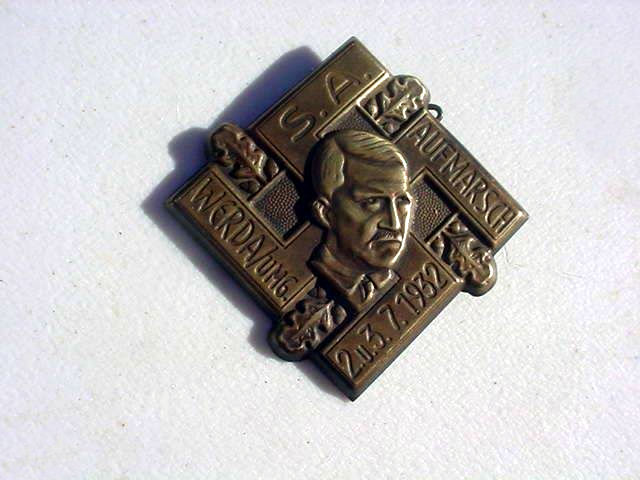
|
Badge Commemorating the SA March through Werda in 1932 (Item SA 15-3; NSDAP 21-28)
|
|
DESCRIPTION: Here is a most beautiful tinnie. The badge commemorates a major SA march thru the tiny city of Werda in 1932. The badge depicts in its background a swastika that is in the full proportion of the badge. In the center of the badge is a very fine depiction of Adolf Hitler. The arms of the swastika are decorated in oak leaves and the wording on the arms are as follows: “S.A. AUFMARSCH WERDA/UM6. 2.u.3.7. 1932.”
PRICE: $195.00
|
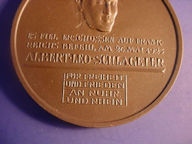
|

|
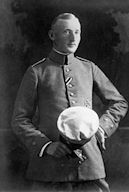
|
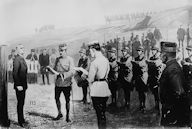
The young hero faces the occupying murderers' firing squad.
|
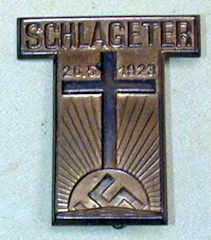
|

|
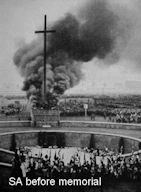
The SA gathers before the memorial.
|
Commemorative Porcelain Medallion (Item SA 15-4; NSD 22-2; FREI 1-15)
|
|
DESCRIPTION: This medallion is dedicated to the memory of Albert Leo Schlageter, the martyred hero who defended his sacred Fatherland and his Deutsches Volk. He was a member of the German Freikorps, and his activities sabotaging French occupying troops after World War I led to his arrest and eventual execution (murder) by the occupying French forces. His way of death fostered an aura of martyrdom around him, which was cultivated by German patriotic nationalist groups, in particular the National Socialist Party. During the Third Reich, he was widely commemorated as a national hero and a genuine Teutonic warrior who died for what to him was a glorious cause. The medallion is of the type and style of the various Meissen porcelain commemoratives. Under the Schlageter cross on the reverse side are the dates “26 Mai 1923” and “26 Mai 1933.” On the obverse side there is a depiction of a bust portrait of the hero and under this (translated) it says: “He fell slain by France’s order on 26 May 1923,” and below his name it has a little box that has the message that translates to: “For peace and freedom for the Ruhr and the Rhine.” The size is about 3 1/2 inches in diameter and it is in perfect condition. This is a true historic treasure honoring a young hero and martyr who refused to renounce his faith in his just cause in the name and spirit of his German fatherland. Please go here to view another award for Schlageter at Item FREI 1-1.
PRICE: $275.00
|

|

|
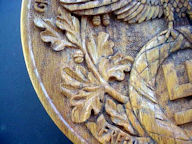
|
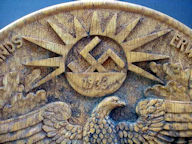
|

The wire hanger was added by the consigner.
|
Beautifully Carved Wooden Plate from the “Kampfzeit” (Struggle for Power) (Item SA 15-2; NSD 22-3; ART 18-7; WOODMASTER 1-12; BRE 1-7)
|
|
DESCRIPTION: This is without a doubt the most beautiful carved commemorative plate that we have ever seen and certainly with the greatest meaning. In 1933, Adolf Hitler was appointed as Reichs Chancellor. The whole meaning of the plate is to commemorate this important world event. The plate has at the top a swastika within the figure of rising a sun. The central design is the large, early NS Party eagle perched upon the early nonmobile swastika that is within a wreath with the date “1933” below it. The meaning is quite deep and has to do with the Machtergreifung (The Seizure of Power). Behind the eagle’s wings are sprays of oak leaves and acorns, the ancient German symbol of victory. Along the edges are the separate cutout words “GROßDEUTSCHLANDS ERWACHEN” (Greater Germany’s Awakening). Below the wreathed swastika are the watchwords (“Freedom and Bread”) of the NS movement “Freiheit u. Brot.” The plate measures 11 inches in diameter. It is in wonderful condition with no parts of the carving missing. All of the artwork is deeply cut and raised. It is probably the finest woodcarving that we have ever seen and would be considered not only extremely rare but also exceedingly beautiful when one looks at the carved wording that is all individually hand cut with fantastic skill; you can realize that this is one of the true artistic treasures of the early Third Reich.
PRICE: SOLD
|
|
|
|
Book Entitled Liederbuch Schleswig-Holsteinischer (Item SA 15-3, PARTYSONGBOOK 1-1; SS 38-27)
|
| DESCRIPTION: This is rare one printed in 1934 by the book handlers for the National Socialist Party under the auspices of Hans Schumm printing in Altona Elbe. The book comprises 64 pages with all the early party favorites such as “Argonnerwald,” “Deutschland erwacht!,” “Deutschland über alles,” “Horst Wessel Lied,” “Hitlerlied,” ”Hitler-Jugend-Lied,” “Den Toten des 9 November 1923,” “Annemaria,” “Marschlied der SS,” “Volk ans Gewehr,” “Wenn alle untreu werden,” and the Hitler Youth song “Unser Fahne flattert uns voran” plus many more N.S. favorites that were sung by patriotic citizens and party functionaries. Nothing thrills quite like great Volkslieder and Parteilieder.
PRICE: SOLD
|
|
|
|
SA Shoe Polish Canister (Item SA 15-4)
|
| DESCRIPTION: The can measures 2½ inches in diameter and almost an inch deep. It has the words “SA Marschiert” (“SA march”) with a caricature of a brown shirt trooper that is seen below. Under this is a German word that refers to maintenance (polish?) Wouldn’t it be somewhat neat to add this to your SA collection? There is no product in the canister (empty).
PRICE: SOLD
|

|

Inside the front cover
|
|
|
SA Booklet Concerning Rules of Honorable Behavior for the Troopers (Item SA 15-5)
|
| DESCRIPTION: This little booklet measures 4 x 5 inches and contains 31 pages that lay out the code of conduct (Ehrenordnung) for the SA Sturmabteilung. “Brownshirts.” Nowadays, the liberals and the Left are forever calling these honorable men thugs, bullies, criminals, but to the contrary, they were, for the most part, honorable, decent, and emphatically patriotic men who served bravely while almost always outnumbered against vicious terrorist Communist fiends of the lowest order: the Antifa of that day. The booklet’s cover is in sort of an oilcloth material so it could be carried in the pocket of those “Brownshirts” and referred to when the occasion called for instruction and advice. The Supreme HQ of the SA issued these booklets in 1933.
PRICE: SOLD
|
| 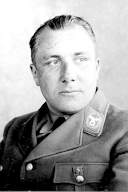
Martin Bormann wearing the prestigious Frontbann badge
|
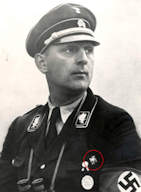
SS official Kurt Kurt Daluege wearing the Frontbann badge
|
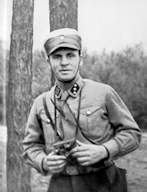
|
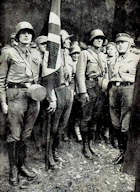
Men of the Frontbann ready for action
|
|
|
Rare Frontbann Badge in Silver; one of the Scarcest Badges of the NSDAP (Item SA 15-6: FREI 1-18)
|
| DESCRIPTION: The Frontbann was a reorganized and renamed version of the SA. It was created in April 1924, as a substitute for the then-banned SA in the aftermath of the failed Beer Hall Putsch of November 1923. The Nazi Party (NSDAP), including the SA, was outlawed by the Weimar Republic government following the putsch. The Nazi Party was briefly renamed the National Socialist Freedom Party to maintain its legality and the SA was similarly renamed. Like the party it served, the Frontbann included the same members and performed the same functions as its predecessor. It contained many of the original members of the SA and was still led by Ernst Röhm. Frontbann units were formed throughout Germany. Kurt Daluege was the leader of the Frontbann unit in Berlin and Martin Bormann was a member of the unit in Thüringen. It had about 30,000 members across Germany. The Frontbann was disbanded on February 27, 1925, when the ban was lifted on the Nazi Party and was reformed back into the SA. The Frontbann badge is an official Abzeichen (insignia) worn and highly respected as the symbol of extreme loyalty and dedication to the NSDAP and its agenda. This is definitely not a day-badge or a tinny. It’s comprised of a 20-mm (a little more than 3/4 of an inch) swastika with a German helmet centered on it. The badge was struck in silver and is marked with the “800” silver marking. Written on the legs of the swastika are the words “WIR WOLLEN FREI WERDEN (“We wish to be free.”). It was listed as an official decoration of the NSDAP and a recognized historical award of the SA created in 1924. The badge is maker marked “LN 1790—Lauer Nürnberg.” The fastening pin is as it is on any official German award badge with a bold, flat pin and a hinged stabilizer fixture at its top and a clutch-holder device at the bottom. Here is an extremely rare badge and award for true heroic action against the disease known as Bolshevism, OR, today, it would be known as the antifa movement!
PRICE: SOLD
|

Jakob Grimminger, standard-bearer of the November 9th Blutfahne
|

|

A memorial to the fallen of November 9, 1923
|
| 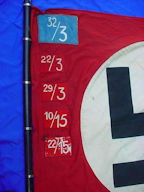
|
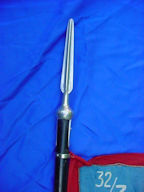
|

|
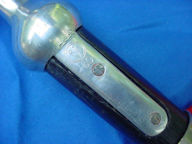
|
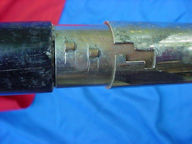
Part of flag section lock: open position
|
| 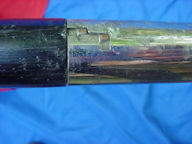
Part of flag section lock: partially locked position
|

|
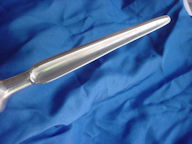
|
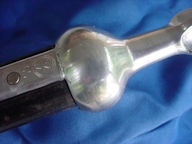
|
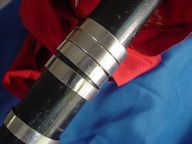
|
| 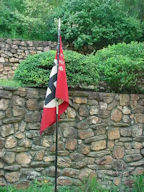
|
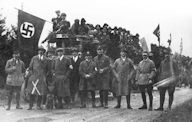
A very early image of NSDAP members with a nonmobile swastika flag. “X” denotes Hitler
|
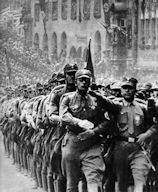
Note the spear-top SA flag in the background
|
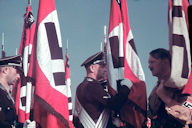
Note that the spear top was used by the  as well as the SA as well as the SA
|

Hochland SA march in Munich in early 1920s
|
| 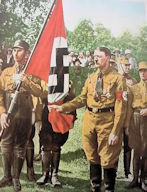
Blood Flag is shown here prior to the consecration of flags and standard
|
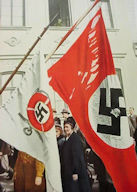
Other sacred traditions flags are paraded in Munich
|
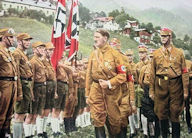
Hochland SA in review before the Führer. NOTE: Lederhosen.
|
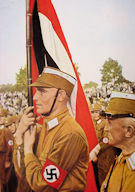
Hochland SA troopers. Notice the blue collar tabs.
|
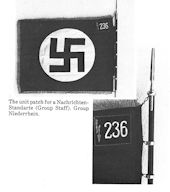
From page 248 in the book The SA: A Historical Perspective by Jill Halcomb
|
|
|
Magnificent Historical SA Unit Flag with Pole and Spear Top (Item SA 15-7; FLAG 5-10, PARTEI 4-18)
|
DESCRIPTION: This is a very important SA flag with the original-issue flagpole. For those collectors who have been around for considerable years they will immediately recognize the name of the late Bob Coleman. Mr. Coleman was the world’s greatest expert on the Sturmabteilung (SA) and it was he that did the expertise on this incredible flag. Here is what Mr. Coleman had to say: “This is an interesting SA Sturmfahne for Sturm 32 Standarte 3 Gruppe Hochland, which was headquartered in Augsburg Scheissgraben Str-16. The additional unit patches indicated other Sturm that were associated into this Sturm. What makes this flag so interesting is a large bloodstain on the middle edge and bottom corner. There are several smaller bloodstains on the red field of the flag.” Mr. Coleman presumed this would have indicated that the flag had been carried by an injured SA member due to a violent encounter with members of the Red Front. He went on to say that he was attempting to research the flag to discover the source of the stains. Blood stained items from the period of struggle were highly revered items in the Third Reich. In a further description, he goes on to say of it: “Flag with these traditions numbers according to the 1938 Order Standarte 3 was for the Augsburg SA group of Hochland. Standarte 15 was Donauwörth, also Hochland. The flag was first held by Sturm 22/15, then handed over to Sturm 10/15 and later to Sturm 29 from Standarte 3 and 22, and finally it ended in the hands of Sturm 32 from Standarte 3. The color for Hochland was light blue. (This was signed Bob Coleman.) In our opinion the flag itself dates very early during the Kampzeit, and was carried as a traditional unit flag and was actually carried into the heat of battle. This is well named as a traditions Kampzeit flag. It seems certain that it was battle tested in the struggle against the horrible Communist menace that beset Germany in those days; therefore, it deserves a place of honor in perpetual display and when this present time of insanity subsides perhaps it will be a featured and honored as it certainly deserves. The Hochland-SA Standarte was one of the toughest of the Brown battalions; they were for the most part Bavarian mountain men and although their tunics and shirts were standard SA issue,the trousers they wore were Lederhosen (leather shorts in parade formation.
Flag Description
The flag is huge!. The cloth comprising the actual flag measures 45 inches wide and 50 inches long. The pole that fits together like a bayonet with a special metal fitting measures altogether at 115 inches. The swastika is of the 1920s style that has the nonmobile configuration that does not tilt as with the later and more recognized style. The later ceremonial flags were usually featured with silver fringe along three of the edges. Make no mistake, here is a battle-scarred and bloodied veteran of the war known as the Kampzeit and that to the NSDAP would be thought of as a “Heilige Reliquie” (Sacred Relic). It is a safe certainty that it was consecrated by the touch of the Blutfahne at the Nuremberg Rally. The spear topper was in all probability added later by one of the SA Sturms because the earliest flags had no actual toppers when they were carried into street combats. The topper bears the RZM stamping. It is generally believed that the spear-point flagpole tops were introduced in the early or middle 1930s and were widely used by both the SA and in some instances by the  . There truly are few historically important items that could match this extremely rare surviving treasure and it should be in a museum or at least a very noteworthy collection. Alles für Deutschland. . There truly are few historically important items that could match this extremely rare surviving treasure and it should be in a museum or at least a very noteworthy collection. Alles für Deutschland.
PRICE: SOLD
|
|
|
|
SA Beer Stein (Item SA 15-9)
|
| DESCRIPTION: Here is a beautiful, little, Munich-style beer stein. It features a great vivid depiction of SA troopers (Brownshirts) at sundown, who, while hoisting the swastika banner, follow the directives of their Sturmbannführer (leader). The coloration of the sky as depicted is absolutely gorgeous! The stein has the typical gray pewter lid and it has what obviously are the initials of the trooper who owned it ("H" "M") along the bottom edge. There's a manufacturer’s mark that shows a crouching lion wearing a crown and the word "Bavaria." It's five inches tall not counting the thumb lift and is truly a great and original historical piece from a turbulent era.
PRICE: SOLD
|

Front
|

Back
|
| 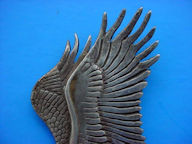
Front wing view
|
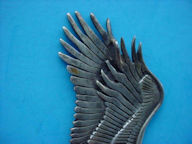
Backside wing view
|
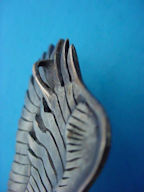
Note disguised attachment loop
|
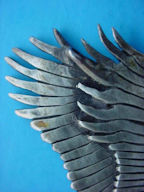
|
|
|
Eagle Prize for SS or SA Unit Standarte or Flag (Item SA 15-10; SS 38-35)
|
| DESCRIPTION: Here is a much coveted prize Abzeichen (insignia) that was issued by the Oberführung of the NSDAP to units of the SA and SS for extreme proficiency in their duties. It was considered a high award and is an extremely rare find by collectors today. It is finished like a fine jeweler's masterpiece in pure "835" silver. It is in the form of swooping eagle carrying the wreathed swastika in his talons. The feathers on the eagle are so beautifully depicted that one could actually count each one separately and the views of the feathers on the front are separately struck and applied and the same treatment is used on the backside, as well—so the piece is double-sided in silver. This practically unique piece would be presented to the deserving Standarte with appropriate ribbons arranged in a bouquet with presentation wordage. The unit would display this for one year on their flag or standard and only one of the SS or SA units would receive one. Then that flag so decorated would go on display at the NSDAP (Brown House) for a year. It should be noted that the workmanship is so fine that the attachment ring is completely worked in such a way as to be integrated into the design of the wing tips. This is probably, without doubt, the most beautiful of all NSDAP insignia and certainly the most respected.
PRICE: $375.00
|
|
|
|
SA Concert Program (Item SA 15-11)
|
| DESCRIPTION: Now this is a real special collectible! It’s a flyer advertising a concert sponsored by the SA. It measures 6 x 9 inches and is in excellent condition.
PRICE: $125.00
|
|
|
|
SA Membership Flyers (Item SA 15-12)
|
| DESCRIPTION: Thousands flocked to join the SA to fight the Communists and these two original flyers are a testament as to how sincere they were to accomplish this objective. These are in mint condition.
PRICE: Both for $125.00; pin NOT included
|
Contact Us
Please refer to item designator in parentheses in all correspondence.
Please E-mail for any additional information you may need.
If you prefer, contact 'Germania' at PO Box 68, Lakemont, GA 30552
or call at 706.782.1668 or 706.782.4398.
Please! do not call during the wee hours of the morning. The best time for calling us is between 9 and 11 am and between 9 and 11 pm eastern
time.
| |
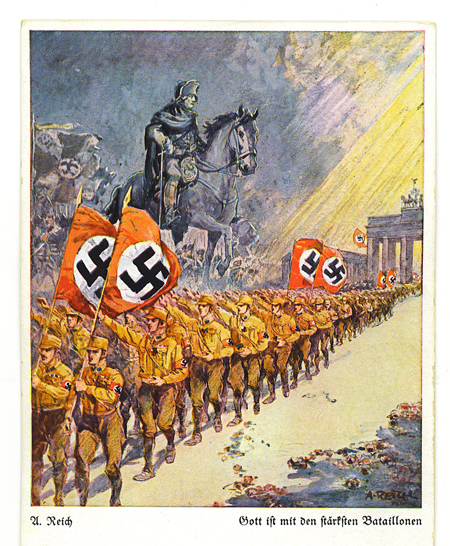



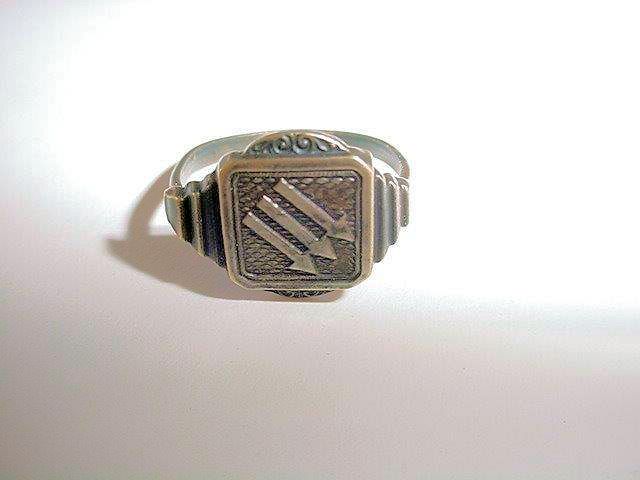
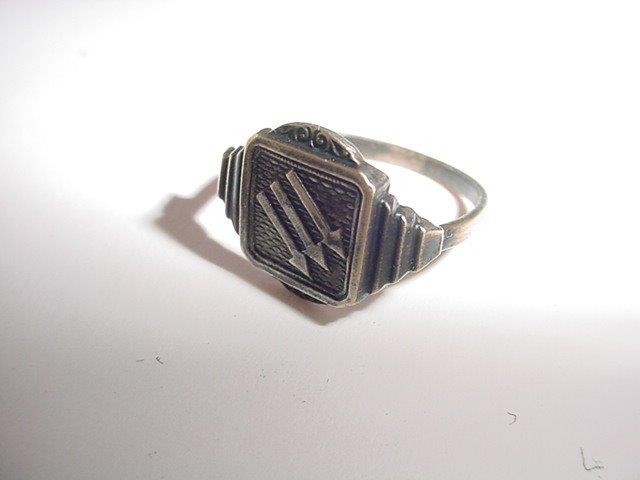








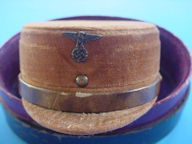
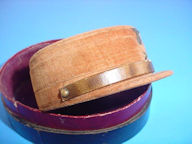
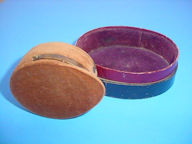

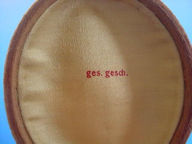





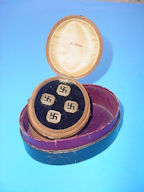
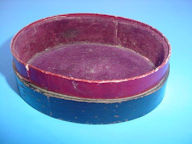
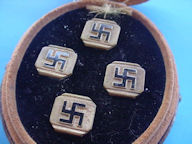
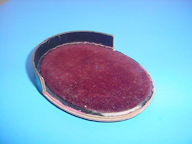
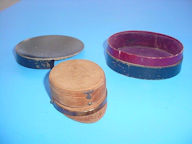
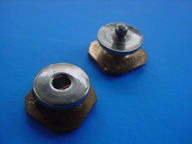
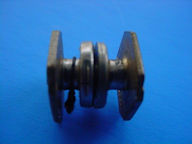



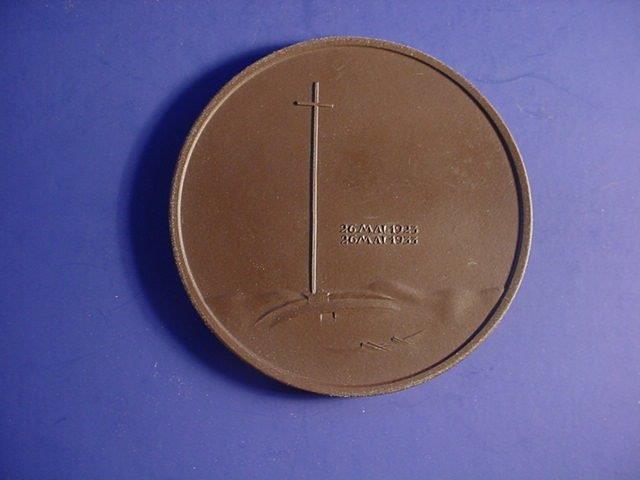








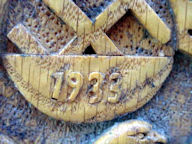

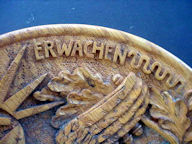
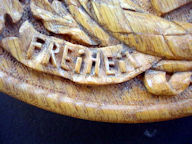





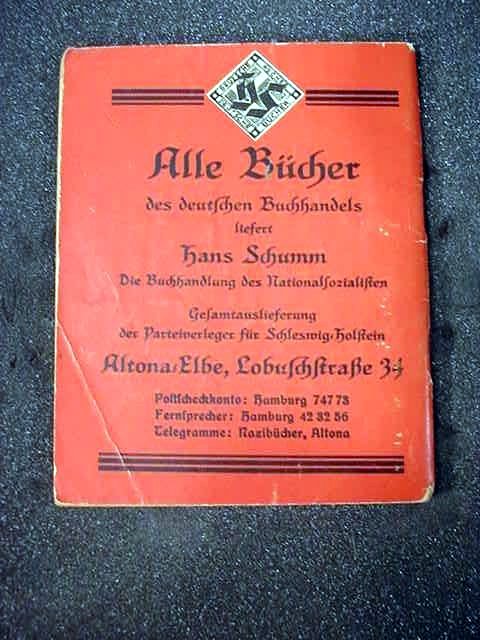
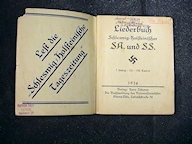
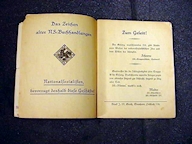
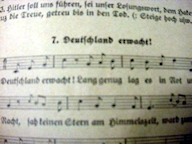
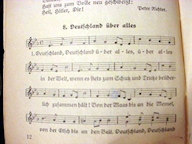
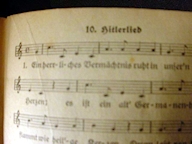
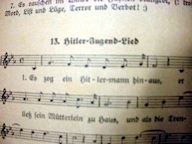


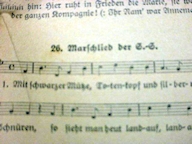






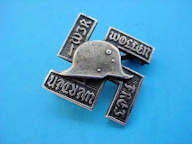
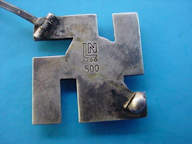
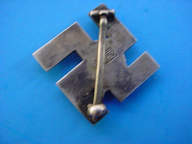
























 as well as the SA
as well as the SA










